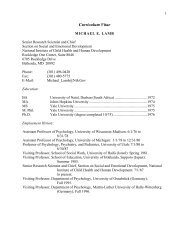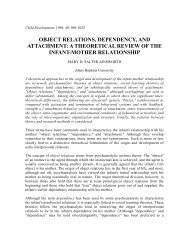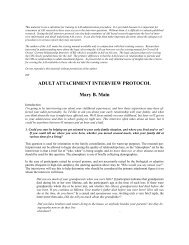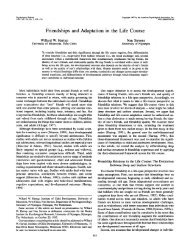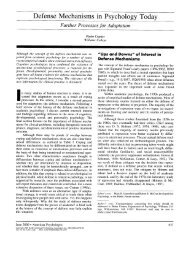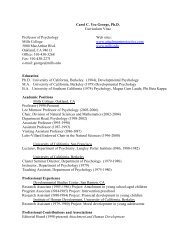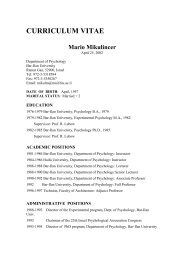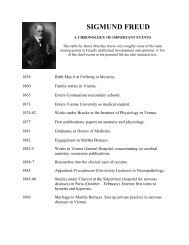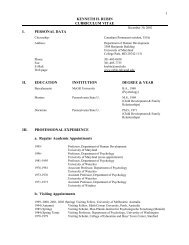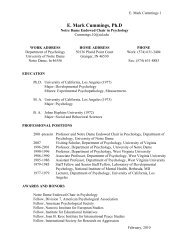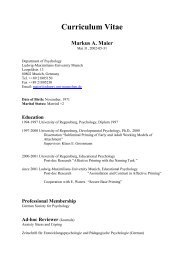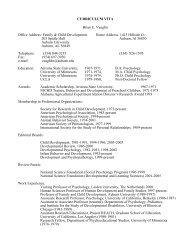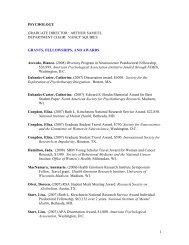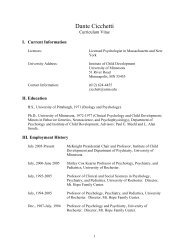the origins of attachment theory: john bowlby and mary ainsworth ...
the origins of attachment theory: john bowlby and mary ainsworth ...
the origins of attachment theory: john bowlby and mary ainsworth ...
Create successful ePaper yourself
Turn your PDF publications into a flip-book with our unique Google optimized e-Paper software.
Robertson protested that he could not continue as an uninvolved research worker, but felt com-<br />
pelled to do something for <strong>the</strong> children he had been observing. On a shoestring budget, with min-<br />
imal training, a h<strong>and</strong>-held cinecamera, <strong>and</strong> no artificial lighting, he made <strong>the</strong> deeply moving film,<br />
A Two-Year-Old Goes to Hospital (Robertson, 1 953a, 1953b; Robertson & Bowlby, 1952).<br />
Foreseeing <strong>the</strong> potential impact <strong>of</strong> this film, Bowlby insisted that it be carefully planned to ensure<br />
that no one would later he able to accuse Robertson <strong>of</strong> biased recording. The target child was<br />
r<strong>and</strong>omly selected, <strong>and</strong> <strong>the</strong> hospital clock on <strong>the</strong> wall served as pro<strong>of</strong> that time sampling took<br />
place at regular periods <strong>of</strong> <strong>the</strong> day. Toge<strong>the</strong>r with Spitz’s (1947) film, Grief: A Peril in Infancy,<br />
Robertson’s first film helped improve <strong>the</strong> fate <strong>of</strong> hospitalized children all over <strong>the</strong> Western<br />
world, even though it was initially highly controversial among <strong>the</strong> medical establishment.<br />
When Mary Ainsworth arrived at Bowlby’s research unit late in 1950, o<strong>the</strong>rs working <strong>the</strong>re<br />
(besides James Robertson) were Mary Boston <strong>and</strong> Dina Rosenbluth. Rudolph Schaffer, whose<br />
subsequent <strong>attachment</strong> research is well known (Schaffer & Emerson, 1964), joined <strong>the</strong> group<br />
somewhat later, as did Christoph Heinicke (1956; Heinicke & Wes<strong>the</strong>imer, 1966), who under-<br />
took additional separation <strong>and</strong> reunion studies, <strong>and</strong> Tony Ambrose (1961), who was interested in<br />
early social behavior. Mary Ainsworth, who was charged with analyzing James Robertson’s data,<br />
was tremendously impressed with his records <strong>of</strong> children’s behavior <strong>and</strong> decided that she would<br />
emulate his methods <strong>of</strong> naturalistic observation were she ever to undertake a study <strong>of</strong> her own<br />
(Ainsworth, 1983).<br />
At this time, Bowlby’s earlier writings about <strong>the</strong> familial experiences <strong>of</strong> affectionless<br />
children had led Ronald Hargreaves <strong>of</strong> <strong>the</strong> World Health Organization (WHO) to commission him<br />
to write a report on <strong>the</strong> mental health <strong>of</strong> homeless children in postwar Europe. Preparation <strong>of</strong> <strong>the</strong><br />
WHO report gave Bowlby an opportunity to pick <strong>the</strong> brains <strong>of</strong> many practitioners <strong>and</strong> researchers<br />
across Europe <strong>and</strong> <strong>the</strong> United States who were concerned with <strong>the</strong> effects <strong>of</strong> maternal separation<br />
<strong>and</strong> deprivation on young children, including Spitz (1946) <strong>and</strong> Goldfarb (1943, 1945). The report<br />
was written in 6 months <strong>and</strong> translated into 14 languages, with sales <strong>of</strong> 400,000 copies in <strong>the</strong><br />
English paperback edition; it was published in 1951 as Maternal Care <strong>and</strong> Mental Health by <strong>the</strong><br />
WHO. A second edition, entitled Child Care <strong>and</strong> <strong>the</strong> Growth <strong>of</strong> Love, with review chapters by<br />
Mary Ainsworth, was published by Penguin Books in 1965.



